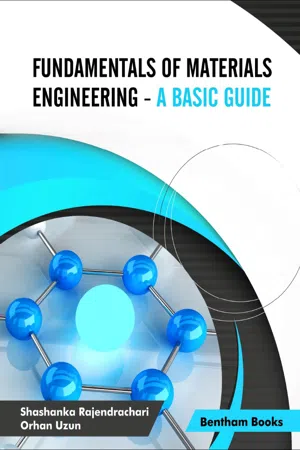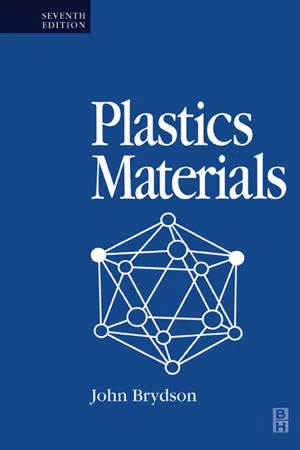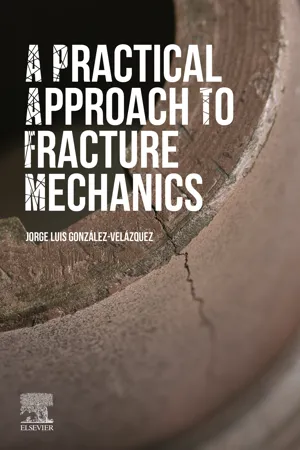Technology & Engineering
Toughness
Toughness refers to the ability of a material to absorb energy and deform plastically without fracturing. It is a crucial property in engineering and technology, especially in the design of structures and materials that are subjected to impact or sudden loads. Toughness is often evaluated through tests such as Charpy or Izod impact tests, providing valuable information for material selection and design considerations.
Written by Perlego with AI-assistance
Related key terms
Related key terms
1 of 4
Related key terms
1 of 3
6 Key excerpts on "Toughness"
- eBook - ePub
Materials
Engineering, Science, Processing and Design
- Michael F. Ashby, Hugh Shercliff, David Cebon(Authors)
- 2009(Publication Date)
- Butterworth-Heinemann(Publisher)
stops things happening. One of the great triumphs of recent engineering science has been the development from the 1960s onward of a rigorous mechanics of material fracture. We have no numbers for the money and lives it has saved by preventing failures; all we know is that, by any measure, it is enormous. This chapter is about the ways in which materials fail when loaded progressively, and design methods to ensure that fracture won’t happen unless you want it to.Sometimes, of course, you do. Aircraft engines are attached to the wing by shear-bolts, designed to fail and shed the engine if it suddenly seizes. At a more familiar level, peel-top cans, seals on food containers and many other safety devices rely on controlled tearing or fracture. And processes like machining and cutting use a combination of plasticity and fracture.We start by distinguishing strength from Toughness . Toughness—resistance to fracture—requires a new material property, the fracture Toughness developed in Section 8.3 , to describe it. This new property is explored in Section 8.4 using charts like those we have already seen for modulus and strength. The underlying science mechanisms (Section 8.5 ) give insight into ways in which Toughness can be manipulated (Section 8.6 ). The chapter ends in the usual way with a summary, suggestions for Further reading and Exercises.8.2 Strength and Toughness
Strength and Toughness? Why both? What’s the difference?
Strength , when speaking of a material, is its resistance to plastic flow. Think of a sample loaded in tension. Increase the stress until dislocations sweep right across the section, meaning the sample just yields, and you measure the initial yield strength . Strength generally increases with plastic strain because of work hardening, reaching a maximum at the tensile strength . The area under the whole stress–strain curve up to fracture is the work of fracture . We’ve been here already—it was the subject of Chapter 5 .Toughness is the resistance of a material to the propagation of a crack. Suppose that the sample of material contained a small, sharp crack, as in Figure 8.1(a) . The crack reduces the cross-section A and, since stress σ is F /A , it increases the stress. But suppose the crack is small, hardly reducing the section, and the sample is loaded as before. A tough material will yield, work harden and absorb energy as before—the crack makes no significant difference. But if the material is not tough (defined in a moment) then the unexpected happens; the crack suddenly propagates and the sample fractures at a stress that can be far below the yield strength. Design based on yield is common practice. The possibility of fracture at stresses below the yield strength is really bad news. And it has happened, on spectacular scales, causing boilers to burst, bridges to collapse, ships to break in half, pipelines to split and aircraft to crash. We get to that in Chapter 10 - eBook - ePub
- Henry Tindell(Author)
- 2014(Publication Date)
- Crowood(Publisher)
In order to assess effectively the fitness-for-purpose of a design, including its materials, it is necessary to understand modes of failure and fracture mechanisms. Experience demonstrates that most engineering failures are not due to simple yielding past the design limit, with ductile deformation before an orderly collapse as the ultimate stress is reached, following gentle plastic flow to that point. In reality, failure normally occurs, after reaching critical fatigue crack length, in a sudden and rapid manner involving ‘brittle’ fracture, at velocities up to the speed of sound in the metal. This was the scenario described earlier as the Comets exploded, with fast fracture of its thin and ductile material; and is seen when large pressure vessels fracture; or when cargo ships break up through fractures in heavy seas, with a speed that doesn’t even give the hapless crew a chance to raise a distress call. The continuing loss of large cargo tankers on the high seas, in mysterious circumstances, is highly likely to be from this mode of failure, with the evidence residing on the ocean floor for ever.This leads to the concept of material ‘Toughness’, defined as an ability to sustain loading in the presence of defects, particularly cracks. The value of Toughness is often as important as strength and stiffness, primarily because real structures will normally contain defects. Although, in the most favourable cases, these will be microscopic, in many instances they may already be significant, arising from welding or processing. Their stability is critical to safe engineering.It was not until the latter half of the twentieth century that it eventually became possible to quantify Toughness as an engineering property, and apply it in a scientific manner to the real world of structures and products. Before then, failures of an unexpected and often catastrophic nature were not uncommon; their avoidance was due to three major features:1. Factors of safety were often very high, reducing operational stresses, but incurring the weight penalty of oversized parts.
2. Relatively thin and low-strength material was the norm, permitting local yielding, but precluding the safe deployment of heavy-wall construction, such as is required in modern nuclear power stations.3. Structures and vessels were joined by mechanical means, such as bolting or riveting. This has now largely been replaced with welding, producing monolithic designs which do not have the crack-arresting facilities offered by amalgams of individual components. - Shashanka Rajendrachari, Orhan Uzun(Authors)
- 2021(Publication Date)
- Bentham Science Publishers(Publisher)
4 ]. Toughness is measured by calculating the area under the stress-strain curve from a tensile test and it is the unit of energy per volume. One of the metals having maximum Toughness is Tungsten, and its Toughness can be significantly increased by alloying with suitable metals.Fig. (7)) The stress-strain curve showing the Toughness [4 ].5.8. Resilience
It is the ability of a material to rebound elastically into the original shape. In other words, it is the total energy absorbed by the materials during elastic deformation. Fig. (Fig. (8)) (a) Load-extension diagram showing resilience. (b) Stress-strain diagram showing modulus of resilience [4 ].) shows the resilience and modulus of resilience in load-extension and stress-strain diagrams, respectively [4 ]. It is the area up to the elastic limit, as shown in the figure.8The maximum amount of energy absorbed up to the elastic limit, without permanent distortion, is called proof resilience. Similarly, the modulus of resilience is defined as the maximum energy that can be absorbed per unit volume without permanent distortion. The unit of resilience is joule per cubic meter (J/m3 ).5.9. Stiffness
Stiffness is expressed by Young’s modulus, and it is defined as the resistance of material for elastic deformation.
The values of both true stress and true strain are from the elastic region, and it does not affect by alloying or change in the microstructure.5.10. Ductility
Ductility is an ability of a material to stretch under tensile stress before fracture. In other words, it can also be defined as an ability of a material to drawn in to thin wire. Generally, ductility can be expressed in terms of percentage elongation, and it is given as below;
Ductility of a material can be graphically represented as below:Fig. () represents the load-extension diagram showing the ductility of materials [4 ]. Examples of ductile materials are copper, aluminum, steel, and some more metals. Ductility is a physical property, and it is not having any unit.95.11. Malleability
Malleability is just opposite to that of ductility. In the case of the ductility test, tensile forces are used, but here compressive forces are used. It is defined as the ability of a material to undergo plastic deformation before fracturing under compressive stress. It can also be defined as the ability of a material to undergo rolling or flattening into thin sheets. Most of the metals with high ductility also possess greater malleability, and it can be measured by % reduction in the cross-sectional area of the material under study.- Lars-Erik Svensson(Author)
- 2017(Publication Date)
- CRC Press(Publisher)
Chapter 5Relation Between Microstructure and Mechanical Properties
5.1. Introduction
The safe use of an engineering structure relies on each of its components possessing the necessary mechanical properties, the most important of these properties usually being strength and Toughness. The main points described in this chapter are how these properties are measured and how they can be influenced by changes in the microstructure. Tensile testing alone is not enough to characterize the properties of the steel because the tendency for brittleness, which occurs at lower temperatures, also must be accounted for. Toughness testing is thus necessary. Impact Toughness testing is often used, but a fracture mechanics approach is frequently necessary. In the heat-affected zone (HAZ), brittle behavior can be found in several zones, such as the coarsegrained zone, the intercritically heated zone, and the subcritical zone. A special problem relates to the so-called local brittle zones (LBZs) that appear in the intercritically heated zone or in the intercritically reheated coarse-grained regions. In the weld metal, the same fundamental correlation between micro-structure and properties exists as in the HAZ. However, additional complications may arise due to the relatively high content of nonmetallic inclusions. Also, the fact that the weld metal is a cast structure that leads to pronounced chemical segregation can affect the mechanical properties, especially Toughness.5.2. Test Methods
The two most common testing methods are tensile and impact Toughness testing. Other tests include bend testing and fracture mechanics. Uniaxial tensile tests use round, smooth tensile bars. Four different values are measured: yield strength, ultimate tensile strength, fracture elongation, and cross-sectional area reduction at fracture. The strength values can be found from the stress-strain curve (Figure 5.1 ). The yield point is reached after approximately 0.1 to 0.5% plastic strain. For many steels there is an upper (ReH) and a lower (ReL) yield point. There can be a difference of 20 to 40 MPa betweenReHandReLfor an ordinary mild steel. For higher alloyed steels and for heat-treated samples, the stress-strain curve does not show a clearly defined yield point, but a smooth transition from an elastic to a plastic deformation. In such cases, the yield stress is defined as the stress at which 0.2% plastic stress has occurred,Rp0.2- eBook - ePub
- J A Brydson(Author)
- 1999(Publication Date)
- Butterworth-Heinemann(Publisher)
British Plastics and Rubber )Other tests occasionally quoted are the BS softening point test and the Martens test. These involve the bending under load of samples held at one end as they are subjected to a rise in temperature.9.3 Toughness
For many applications the resistance to impact is the most important property of a plastics material. It is also notoriously one of the most difficult to assess.If a polymer with no secondary transitions is struck a blow at some temperature well below its glass transitions temperature, deformation will be very limited before fracture occurs. Nevertheless because of the high modulus quite high tensile strengths will be recorded, of the order of 8000 lbf/in2 (55 MPa). The energy to break will be given by the area under the stress–strain curve and will not be very large (see Figure 9.3 ).Figure 9.3 Stress–strain curves for (a) rigid amorphous plastics material showing brittle fracture and (b) rubbery polymer. The area under the curve gives a measure of the energy required to break the test piece.On the other hand, if an amorphous polymer is struck above the T g , i.e. in the rubbery state, large extensions are possible before fracture occurs and, although the tensile strength will be much lower, the energy to break (viz. the area under the curve) will be much more, so that for many purposes the material will be regarded as tough.A common requirement is to produce a rigid plastics material with the Toughness of a rubber. This can be achieved in a number of ways:(1) By the use of a moderately crystalline polymer with a T g - eBook - ePub
- Jorge Luis González-Velázquez(Author)
- 2020(Publication Date)
- Elsevier(Publisher)
5.2. Materials selection for fracture resistance
At this point it is clear that the remaining strength of cracked bodies depends primarily on fracture Toughness, but as well on the yield strength. It is known that for the same material and temperature, fracture Toughness and yield strength are inversely related, as shown in Fig. 5.5 . The use of high Toughness material displaces the RSC upward and to the right, expanding the net section dominance zone whereas the use of hard materials (high σ 0 and low KIC), displaces the RSC downward and to the left, expanding the crack control zone.The behavior described above makes it necessary to establish quantitative criteria for material selection that consider the interrelations among mechanical and fracture properties, as well as other physical properties. Table 5.1 provides a general recompilation of the fundamental mechanical properties (Young’s modulus, yield strength, ultimate tensile strength) and the fracture Toughness for several common metallic alloys and engineering materials. Note that the Young’s modulus is several hundred up to thousands of times higher than the tensile strength, whereas fracture Toughness varies in the range of 0.1MPa√m for plastic foams, up to 280MPa√m for stainless steels.Figure 5.5 Fracture Toughness as a function of yield strength for structural steel and heat-treated aluminum alloys. Approximated data.Table 5.1Typical values of yield strength and plane strain fracture Toughness of common engineering materials.Group Material E (GPa) σ ys(MPa)σuts(MPa)K IC(MPa√m)Ferrous alloys Low C steel 200–215 250–400 340–580 40–80 Medium C steel 200–216 300–900 400–1200 12–92 High C steel 200–215 400–1200 550–1640 27–92 Low alloy steel 201–217 400–1100 460–1200 14–200 Stainless steel 189–210 170–1000 480–2240 62–280 Cast iron 165–180 215–790 350–1000 20–55 Nonferrous alloys
Index pages curate the most relevant extracts from our library of academic textbooks. They’ve been created using an in-house natural language model (NLM), each adding context and meaning to key research topics.
Explore more topic indexes
Explore more topic indexes
1 of 6
Explore more topic indexes
1 of 4





